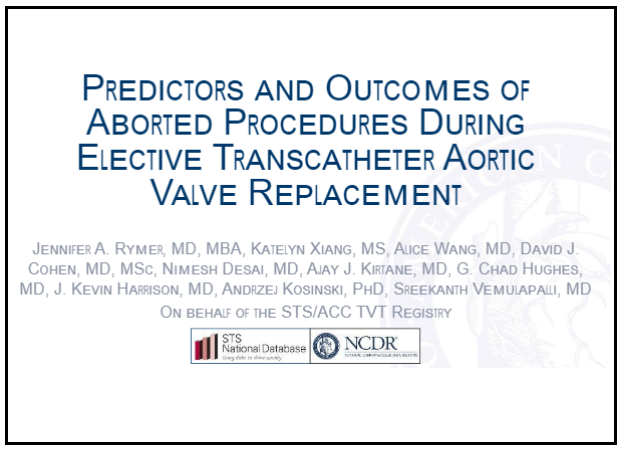Aborted TAVR Procedures Are Waning in the US
Lower institutional volume, PAD, and female sex remain predictors of stopped procedures or conversion to surgery.

The proportion of TAVR attempts in the United States that are aborted midprocedure is on the decline, but a new snapshot suggests that lower institutional TAVR volumes are a key predictor of these decisions, as are female sex and presence of peripheral artery disease.
The data, pulled from the Society of Thoracic Surgeons/American College of Cardiology (STS/ACC) TVT Registry, also indicate that adverse outcomes are more common among patients whose procedures were abandoned or converted to surgery.
Jennifer Rymer, MD (Duke Clinical Research Institute, Durham, NC), and colleagues reported their findings online August 28, 2019, in JACC: Cardiovascular Interventions.
TAVR research has typically focused on outcomes with completed implants, whereas procedures attempted, but aborted, are less commonly discussed, Rymer and colleagues note. They point to an analysis of the German Aortic Valve Registry indicating that about 5% of procedures had to be stopped or converted to open surgery, but US data has not been subject to the same analyses.
“Before this paper we really didn’t have a sense of what the incidence of aborted TAVR procedures was in the United States,” Rymer told TCTMD. “Comfortingly, out of about 100,000 procedures, a little over a 1,000 were aborted, so that’s down to around 1% and it’s been decreasing more and more in recent years. So I think that that’s really the biggest message: that TAVR technology has improved, vascular access has improved, and over the years as centers have increased their experience we’ve seen a really great reduction in the number of aborted procedures.”
Predictors of Halted Procedures
To dig into US numbers, Rymer and colleagues reviewed elective TAVR procedures done between 2011 and 2017 in the STS/ACC TVT Registry—a total of 106,169 patients, from 524 US hospitals. In all, 1,150 procedures (1.1%) were aborted due either to limitations of the device (581) or to other reasons (569), including patient-related characteristics. Female sex, a history of peripheral artery disease, chronic lung disease, or more advanced chronic kidney disease were all associated with an increased likelihood of having to stop a transcatheter valve implantation midprocedure.

In a finding that speaks to the ongoing discussions in the United States over the link between operator/institutional volumes and outcomes, Rymer et al found that aborted procedures were more common at lower-volume centers. Of note, though, the overall trend in aborted procedures declined over the study period, falling from 3.9% in 2011 to 0.7% in 2017.
Strikingly, the rate of 30-day death or stroke was markedly higher among patients whose procedures had been aborted—25.2% versus 6.0%. Rates of this combined endpoint and the composite of vascular complications and bleeding were lower among patients whose failed procedures were device-related as opposed to those aborted for other reasons.
A subanalysis looking only at the most recent TAVR procedures (2015-2017) showed a similar pattern in terms of predictors of aborted interventions; however, the overall rate of aborted TAVR in 2017 reached 0.5% in an analysis restricted to transfemoral procedures.
From the Supplements to the Front Page
In an accompanying editorial, Heath S.L. Adams, MBBS (St Thomas’ Hospital, London, England), and colleagues point out that information on aborted TAVR numbers in the United States is welcome, given that this has, in the past, been relegated to “to the depths of the supplementary index without comment on patient outcomes.”
Speaking with TCTMD, Bernard Prendergast, DM (St Thomas’ Hospital), senior author on the editorial, sees the glass as half full. “The paper is interesting in that it reasserts how successful TAVR has become,” he said. “Obviously the focus is on the aborted procedures and the outcomes associated with that, but if you flip it the other way around, it also emphasizes how rare an event that is in modern practice. Looking at the sequence of registry outcomes over time, the frequency of unsuccessful or aborted procedures has fallen successively from 5, to 3, and now to almost 1 or 2 percent, which is quite remarkable when you think about the clinical characteristics of the patients who are referred to TAVI services today.”
This improvement, he continued, can be credited to technological advances with the devices, their delivery systems, and the imaging used to help make treatment decisions. But credit is also due to the heart teams that have grown so experienced with patient selection, he said.
“We have become very good at the procedures, and we’ve become very good at identifying patients who are not suitable for the procedures,” Prendergast said. “It’s an endorsement of heart team selection processes, and it's an endorsement of the widespread use of CT scanning in particular to tell us about the feasibility of vascular access. I think those are important messages in themselves.”
Rymer, likewise, stressed that heart-team experience likely played an important role, as reflected in the fact that halted procedures were more common at centers with lower patient numbers. “Paying attention to the data that we have on institutional thresholds is necessary, not only because you are picking the right patients, but also because you have adequate amounts of experience, you have institutional backup, and surgical backup—all those factors could be at play as to why institutional volume was a factor associated with an aborted procedure, “she said. “This, to me, speaks to the notion that institutional threshold volumes are still important as has been demonstrated and discussed earlier this year.”
Note: Study co-author Ajay Kirtane, MD, is a faculty member of the Cardiovascular Research Foundation, the publisher of TCTMD.
Shelley Wood was the Editor-in-Chief of TCTMD and the Editorial Director at the Cardiovascular Research Foundation (CRF) from October 2015…
Read Full BioSources
Rymer JA, Xiang Q, Wang A, et al. Factors associated with and outcomes of aborted procedures during elective transcatheter aortic valve replacement. J Am Coll Cardiol Intv. 2019;Epub ahead of print.
Adams HSL, Patterson T, Redwood S, Prendergast B. Prior preparation prevents poor TAVR performance. J Am Coll Cardiol Intv. 2019;Epub ahead of print.
Disclosures
- Rymer reports receiving research grants from Boston Scientific and Abbott Vascular and, for this study, was supported by grant from the American College of Cardiology.
- Adams reports having no relevant conflicts.
- Prendergast reports speaker fees from Edwards Lifesciences.


Comments